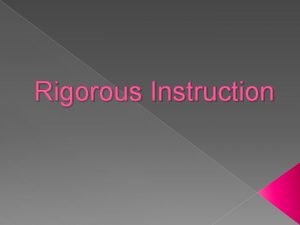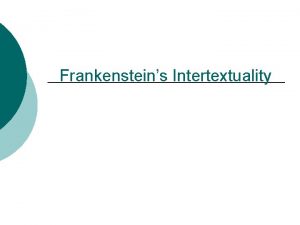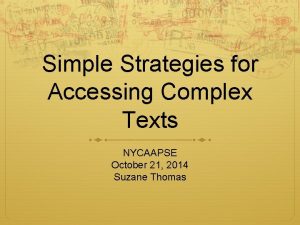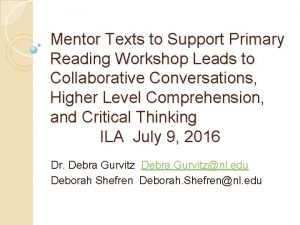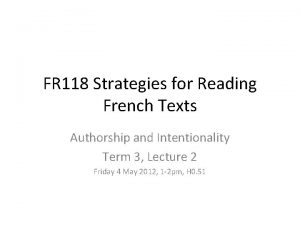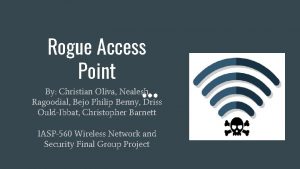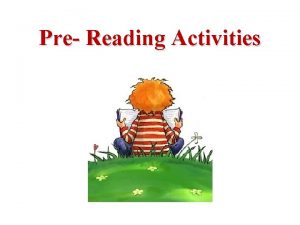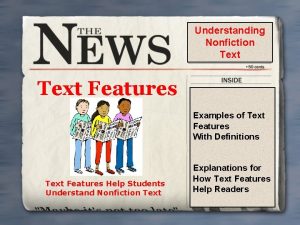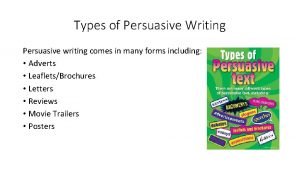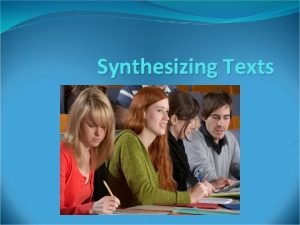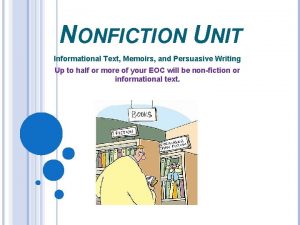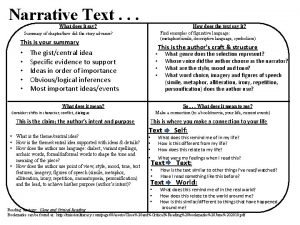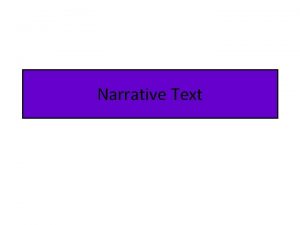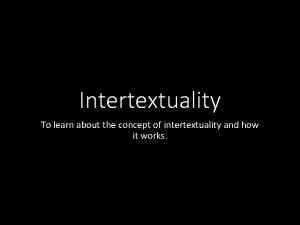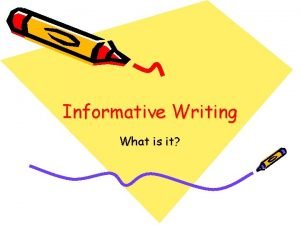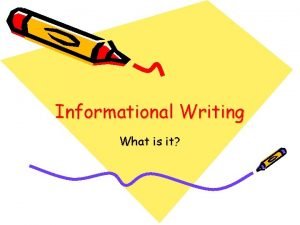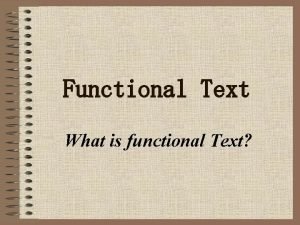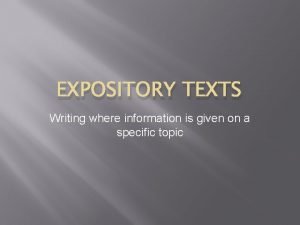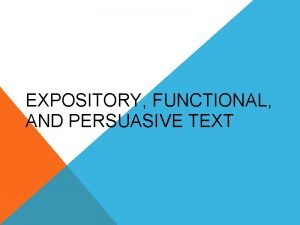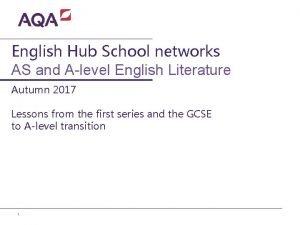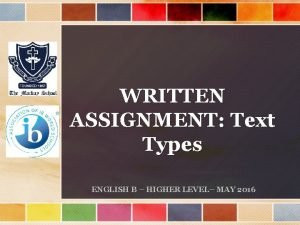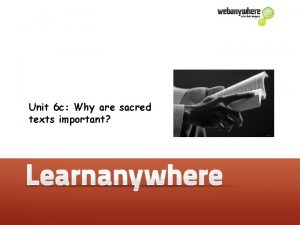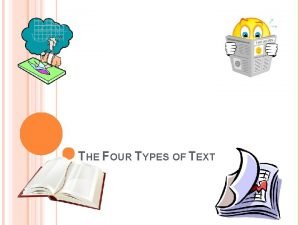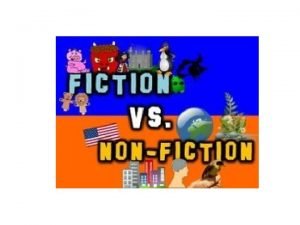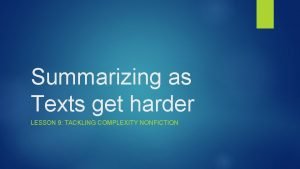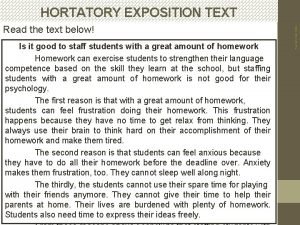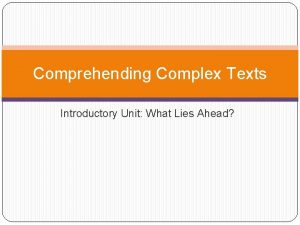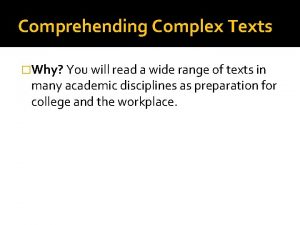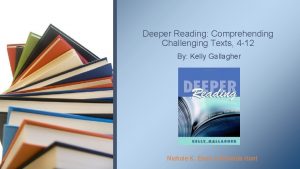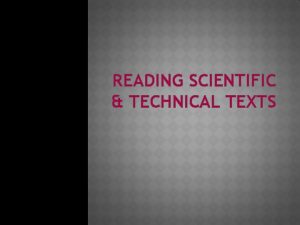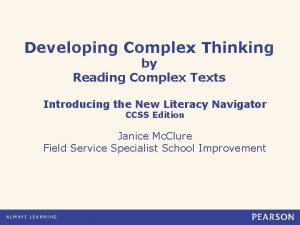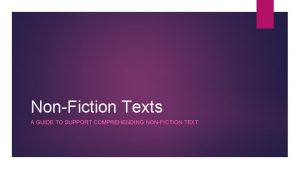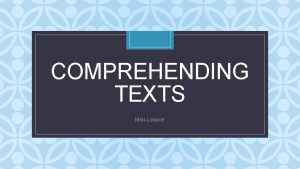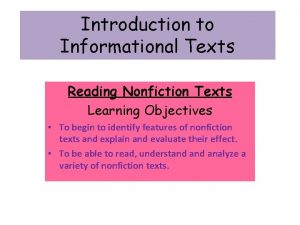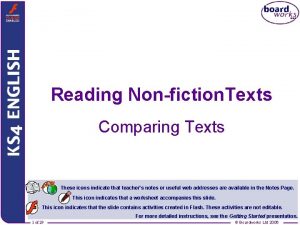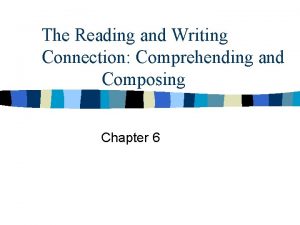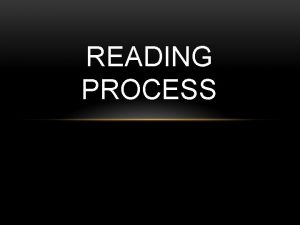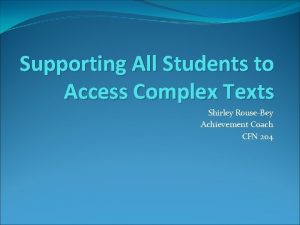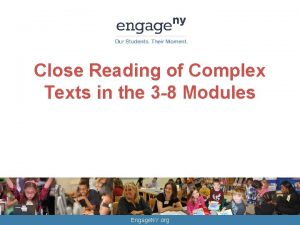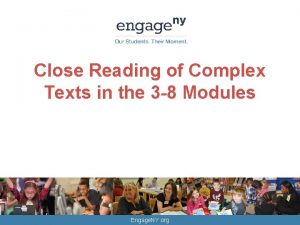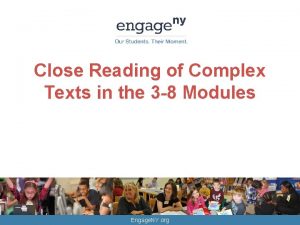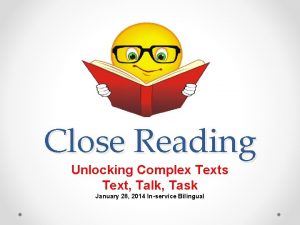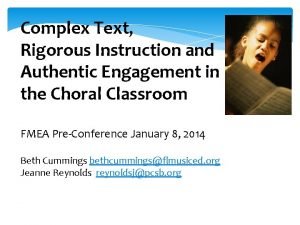Rigorous Reading Access Points for Comprehending Complex Texts





























































































































- Slides: 125

Rigorous Reading: Access Points for Comprehending Complex Texts Nancy Frey San Diego State University

Our Work Today Our learning intention: Build our capacity to use complex texts and foster students’ deep comprehension. Our success criteria: Use a close reading and collaborative learning instructional routine to purposefully teach deep comprehension.

Where to Begin? W. 1 Opinion w/ Evidence (K-5) Argumentation (6 -12) R. 10 Text complexity SL. 1 R. 1 Collaborative Close reading conversations L. 4 Solving unknown words and phrases

Evidence in K How has your practice changed since 2010?

A little background about reading development

To build strength Less Complex To build stamina More Complex

Constrained and Unconstrained Reading Skills Paris, S. G. (2005). Reinterpreting the development of reading skills. Reading Research Quarterly, 40(2), 184202.

Constrained Skills Phonemic Awareness Phonics Fluency

Unconstrained Skills Comprehension Vocabulary

Leveled texts are great for teaching constrained skills. Phonemic Awareness Phonics Fluency

Students restricted to leveled text only fail to learn unconstrained skills. Comprehension Vocabulary

To build strength Less Complex To build stamina More Complex

Literacy should foster inquiry.

TEACHER RESPONSIBILITY “I do it” Focused Instruction Guided Instruction “We do it” Collaborative “You do it together” Independent “You do it alone” STUDENT RESPONSIBILITY A Model for Success for All Students Fisher, D. , & Frey, N. (2014). Better learning through structured teaching: A framework for the gradual release of responsibility (2 nd ed. ) Alexandria, VA: ASCD.

TEACHER RESPONSIBILITY Focused Instruction Establishing purpose primes students for learning.

TEACHER RESPONSIBILITY Focused Instruction Strengthens transitions.

TEACHER RESPONSIBILITY Focused Instruction Provides closure at the end of the lesson.

Establishing Purpose

A clearning target establishes criteria for success

Purpose = Expectations

Establishing Purpose answers the question, “Where are we going? ”

Purpose is essential for English learners.

Want to motivate students? Build their sense of competence.

Our Work Today Our learning intention: Build our capacity to use complex texts and foster students’ deep comprehension. Our success criteria: Use a close reading and collaborative learning instructional routine to purposefully teach deep comprehension.

Our Work Today Our learning intention: Build our capacity to use complex texts and foster students’ deep comprehension. Our success criteria: Use a close reading and collaborative learning instructional routine to purposefully teach deep comprehension.

purpose

Stage and Engage: Guiding Questions What am I learning? Why am I learning it? What are my success criteria and learning intentions?

Team Analysis of Desired Results Analyze the 1 st grade unit essential question, ” What does it mean to be a good citizen and why is it important? ” as well as the Enduring Understandings. How can clearly communicated learning intentions and success criteria contribute to students’ critical thinking, regardless of current reading performance? What would undermine this effort?

Close Reading

Where to Begin? W. 1 Opinion w/ Evidence (K-5) R. 10 Text complexity SL. 1 R. 1 Collaborative Close reading conversations L. 4 Solving unknown words and phrases

Close reading is a PART of balanced literacy instruction pp. xxi-xv

Close reading gives students time to develop unconstrained skills through guided instruction with complex texts.

Differences Between K-2 and 3 -12? In K-2, teacher reads aloud initially, annotates wholly or guides student annotation. Students may or may not eventually read independently, depending on text difficulty (e. g. , Wizard of Oz in Kindergarten. ) In 3 -12, students read independently beginning with first reading, and annotate with increased independence. Readers who cannot initially read independently may be read to, or may encounter the text previously during scaffolded small group reading instruction.

“Every book has a skeleton hidden between its covers. Your job as an analytic reader is to find it. ” Adler and Van Doren, 1940/1972

s i g N e t o y r ve n i d a re o e s o l c a “X-ray the book” ! e n

Use a short passage “Read with a pencil” pp. 46 -53 Creating a Close Reading

Annotation is a note of any form made while reading text. “Reading with a pencil. ”

Annotation in Pre. K-2 • Language experience approach • Interactive writing and shared pen activities

1 2 3 4 5 Modeled Annotation in Kindergarten Kemp, L. M. (1996). One peaceful pond: A counting book. New York: Houghton Mifflin.

Modeled Annotation in First Grade

Modeled Annotation in Second Harvey, S. , & Goudvis, A. (2007). Strategies That Work: Teaching Comprehension for Understanding and Engagement. Portland, ME: Stenhouse.

Even young students can annotate.

Annotation with Wikki sticks

Use a short passage “Read with a pencil” Rereading and discussion Give your students the chance to struggle a bit pp. 46 -53 Creating a Close Reading

The Role of Pre-reading Multiple readings can reduce the need for this

Use a short passage “Read with a pencil” Repeated reading and discussion Give your students the chance to struggle a bit Foster critical thinking with text-dependent questions pp. 50 -56 Creating a Close Reading

• What is familiar to you? • What is new to you? • What is a good tickler?

1. Read closely to determine what the text says explicitly and to make logical inferences from it; cite specific textual evidence when writing or speaking to support conclusions drawn from the text.

Reading Closely Progression K-2 By the end of 2 nd By the end of Ask and answer such questions as who, what, where, when, why, and how to demonstrate understanding of key details in a text. 1 st Ask and answer questions about key details in a text. By the end of With prompting and support, ask and answer questions about key details in a text. K

Anchor Standard 10: Read and comprehend complex literary and informational texts independently and proficiently.

Text Complexity Progression K-2 By the end of 2 nd By the end of 1 st By the end of K By the end of the year, read and comprehend literature, including stories and poetry, in the grades 2– 3 text complexity band proficiently, with scaffolding as needed at the high end of the range. With prompting and support, read prose and poetry of appropriate complexity for grade 1. Actively engage in group reading activities with purpose and understanding.

Read closely… complex texts. 1 10 ELA/Literacy Standards 2 -9

Where to Begin? W. 1 Opinion w/ Evidence (K-5) Argumentation (6 -12) R. 10 Text complexity SL. 1 R. 1 Collaborative Close reading conversations L. 4 Solving unknown words and phrases

Assessing Texts p. 7 -10

Text Quantitative Qualitative Reader Cognitive capabilities Motivation Knowledge Experience Task Teacher-led Peer-led Independent


• Density and Complexity • Figurative Language • Purpose • Standard English • Variations • Register Levels of Structure Meaning Language Convention Knowledge and Clarity Demands p. 9 • Genre • Organization • Narration • Text Features • Graphics • Background • Prior • Cultural • Vocabulary

Text-dependent Questions • Answered through close reading • Evidence comes from text, not information from outside sources • Understanding beyond basic facts • Not recall!

Progression of Text-dependent Questions What does the text inspire you to do? What does the text mean? How does the text work? Interpretive Opinions/Arguments, Intertextual Connections Inferential Inferences Author’s Craft and Purpose Vocab & Text Structure Key Details General Understandings Structural

The Day the Crayons Quit

What did Duncan find when he took his crayons out of the box one day?

Which crayons feel tired and overworked?

What are Yellow and Orange arguing about?

Use Key Details to Locate Evidence

Use Key Details to Locate Evidence How does Gray Crayon feel? Why does Beige Crayon feel underused? How does Blue Crayon feel? To whom was Beige Crayon's letter written? Why does Red Crayon write the letter to Duncan? • According to Black Crayon, what is his main job? • • •

Which crayons appear sad? Embarrassed? How can you tell?

How does Duncan respond to the letters?

Howabowt you & Orange both be the color of the sun? Dear Green, I made the Yellow & Orange’s problem [go away] because I am a good problem solver.

Progression of Text-dependent Questions What does the text inspire you to do? What does the text mean? How does the text work? Interpretive Opinions/Arguments, Intertextual Connections Inferential Inferences Author’s Craft and Purpose Vocab & Text Structure Key Details General Understandings Structural

Vocabulary and Text Structure • Bridges literal and inferential meanings • Denotation • Connotation • Shades of meaning • Figurative language • How organization contributes to meaning

Author’s Craft & Purpose • Genre: Entertain? Explain? Inform? Persuade? • Point of view: First-person, third-person • Narrator: omniscient, unreliable narrator • Literary devices • Intention

Inferences Probe each argument in persuasive text, each idea in informational text, each key detail in literary text, and observe how these build to a whole.

“A Friend” by Gillian Jones

Qualitative Analysis What Makes It Accessible • Story-like with familiar words (high narrativity) • Syntactic simplicity (short sentences) • Lots of connecting words and phrases for deep cohesion (e. g. , and, on whom, Instead, for. ) These connecting terms link ideas. • This deep cohesion facilitates comprehension. What Makes It Complex • Little overlap in words and ideas between sentences. • Vocabulary is abstract (hard to visualize). • Little overlap (referential cohesion) means the reader has to do lots of inferring. • Therefore, students need sufficient prior knowledge.

Initial Readings Read the text to them to get the flow, then a second time to annotate.

What does the text say? General Understanding What is the main idea of the poem?

What does the text say? Key Details What are the qualities of a good friend? How do you know?

What does the text say? Key Details What do you need to do to take care of a friend?

How does the text work? Vocabulary How does the poet help you to understand what the word condemn means?

How does the text work? Vocabulary What does the phrase “lend an ear” mean? Why is this an important quality in a friend?

How does the text work? Structure How does the rhythm and rhyme affect the feeling of the poem?

How does the text work? Author’s Craft How does the poet feel about friendship? What words and phrases does she use that support your answer?

What does the text mean? Inferences How does this poem relate to the Golden Rule?

What does the text mean? Inferences What makes you a good friend?

TALK Talk is essential to writing

“Writing floats on a sea of talk. ” James Britton

What does the text inspire you to do? Writing From Sources What makes you a good friend? After reading and discussing Gillian Jones’s poem, “A Friend, ” write a short paragraph to answer the question. Use what you know from the poem to write your response. Constructed using Elementary Task Template Collection: www. literacydesigncollaborative. org

EXTEND YOUR LEARNING this Afternoon Develop TDQ’s with your grade level team for Unit 1 close readings. Begin with the end in mind: Plan backward and teach forward. 1. What makes the text complex? 2. What do you want students to do with the text? (interpretive) 3. What does the text mean? (inferential) 4. How does the text work? (structural) 5. What does the text say? (literal)

Plan Backwards, Teach Forward 1. What does you want students to do with the text? (Interpretive) 2. What does the text mean? (Inferential) 3. How does the text work? (Structural) 4. What does the text say? (Literal)

It’s not enough to have complex text in the room. Students need to read and discuss complex text.

Comprehension and Collaboration 1. Prepare for and participate in collaborations with diverse partners, building on each others’ ideas and expressing their own clearly and persuasively.

K-2 Features • • Following the rules of discussion Moving from participation to turn taking Sustaining discussion through questioning Adult support

3 -5 Features • • Preparation for discussion Yielding and gaining the floor Posing and responding to questions From explaining own ideas to explaining the ideas of others

20 Days to Productive Group Work

Introduce instructional routines each day during the first month of school (10 -20 minutes).

Tip #1: Begin with the end in mind

Teach students a helping curriculum

Accountable Talk sounds like…

Accountable Talk requires conversational moves by the teacher. Don’t say something students can say.

Conversational Moves of the Teacher Marking: “That’s an important point. ” Challenging students: “What do you think? ” Michaels, et al. , 2010

Conversational Moves of the Teacher Keeping everyone together: “Who can repeat…? ” Michaels, et al. , 2010 Keeping the channels open: “Did everyone hear that? ”

Linking contributions: “Who wants to add on…? ” Expanding reasoning: “Take your time; say more. ” Michaels, et al. , 2010 Verifying and clarifying: “So, are you saying…? ” Pressing for reasoning: “Why do you think that? ” Pressing for accuracy: “Where can we find that? ” Building on prior knowledge: “How does this connect? ”

Introduce Language Frames to Scaffold Accountable Talk Ross, D. , Fisher, D. , & Frey, N. (2009). The art of argumentation. Science and Children, 47(3), 28 -31.

Tip #2: Start Small

On-task Partners On-task partners monitor each other. 1. Follow the direction of the teacher. 2. Check to see if your partner is doing the same thing. 3. If not, quietly help. Make sure they know how to help!

Teaching Your Rules Key to developing community in the classroom and foundational for collaborative conversations.

Discussion Partners TTYPA (Turn to your partner and…) Think-Pair-Square Walking Review Busy Bees Opinion Stations

Social Skills for Discussion Partners Pete the Cat Listening Chart for Kindergarten

Reading Partners Knee-to-knee reading Stronger partner reads first Other student follows silently Now he or she rereads passage Choral reading Silent reading first Mark or discuss phrase boundaries Read aloud together

Response Cards Students furnish answers using prepared cards or original answers written on whiteboards Prepared Cards and Write-on boards True/false shower board Math symbols chalkboards Vocabulary Plickers!

Conversation Roundtable 1 My notes 3 What Alex said What Mayra said 5 Independent Summary 2 4 What Leo said

Noise Meter

Tip #3: Start where you’re comfortable

Tip #4: Teach it

Introduce instructional routines each day during the first month of school (10 -20 minutes).

Taking it Back

Our Work Today Our learning intention: Build our capacity to use complex texts and foster students’ deep comprehension. Our success criteria: Use a close reading and collaborative learning instructional routine to purposefully teach deep comprehension.

Tomorrow’s Decisions 1. What is the easiest thing you can change? 2. What is the first, small change you will begin tomorrow?

1. What are goals for your class regarding complex texts, close reading, and collaborative conversations? 1. How will your grade band look and learn from one another? This Week’s Professional Conversations

A Plan to Begin W. 1 Opinion w/ Evidence (K-5) Argumentation (6 -12) R. 10 Text complexity SL. 1 R. 1 Collaborative Close reading conversations L. 4 Solving unknown words and phrases

A Plan to Begin SL. 1 Collaborative conversations

A Plan to Begin R. 10 Text complexity

A Plan to Begin W. 1 Opinion w/ Evidence (K-5)

A Plan to Begin Formative Assessment

Thank you! www. fisherandfrey. com
 What is rigorous
What is rigorous Rigorous testing in software testing
Rigorous testing in software testing Rigorous method
Rigorous method Rigorous not ruthless
Rigorous not ruthless This refers to the
This refers to the Kind of intertextuality
Kind of intertextuality Accessing complex texts
Accessing complex texts While reading activities
While reading activities Mentor texts for reading workshop
Mentor texts for reading workshop French texts for reading
French texts for reading Brand frame of reference
Brand frame of reference Point of difference and point of parity
Point of difference and point of parity Pauline and bruno have a big argument
Pauline and bruno have a big argument Miliary tb
Miliary tb Simple, compound and complex sentences quiz
Simple, compound and complex sentences quiz The electra complex
The electra complex Contemporary psychodynamic theories
Contemporary psychodynamic theories Difference between oedipus complex and electra complex
Difference between oedipus complex and electra complex Raspberry pi rogue ap
Raspberry pi rogue ap Terminal access controller access control system plus
Terminal access controller access control system plus Terminal access controller access-control system
Terminal access controller access-control system Grandmother poem bridging text and context answers
Grandmother poem bridging text and context answers Fspos
Fspos Typiska drag för en novell
Typiska drag för en novell Nationell inriktning för artificiell intelligens
Nationell inriktning för artificiell intelligens Vad står k.r.å.k.a.n för
Vad står k.r.å.k.a.n för Varför kallas perioden 1918-1939 för mellankrigstiden
Varför kallas perioden 1918-1939 för mellankrigstiden En lathund för arbete med kontinuitetshantering
En lathund för arbete med kontinuitetshantering Personalliggare bygg undantag
Personalliggare bygg undantag Tidbok för yrkesförare
Tidbok för yrkesförare Sura för anatom
Sura för anatom Vad är densitet
Vad är densitet Datorkunskap för nybörjare
Datorkunskap för nybörjare Boverket ka
Boverket ka Att skriva debattartikel
Att skriva debattartikel Autokratiskt ledarskap
Autokratiskt ledarskap Nyckelkompetenser för livslångt lärande
Nyckelkompetenser för livslångt lärande Påbyggnader för flakfordon
Påbyggnader för flakfordon Formel för lufttryck
Formel för lufttryck Publik sektor
Publik sektor Urban torhamn
Urban torhamn Presentera för publik crossboss
Presentera för publik crossboss Argument för teckenspråk som minoritetsspråk
Argument för teckenspråk som minoritetsspråk Vem räknas som jude
Vem räknas som jude Klassificeringsstruktur för kommunala verksamheter
Klassificeringsstruktur för kommunala verksamheter Luftstrupen för medicinare
Luftstrupen för medicinare Claes martinsson
Claes martinsson Cks
Cks Byggprocessen steg för steg
Byggprocessen steg för steg Mat för idrottare
Mat för idrottare Verktyg för automatisering av utbetalningar
Verktyg för automatisering av utbetalningar Rutin för avvikelsehantering
Rutin för avvikelsehantering Smärtskolan kunskap för livet
Smärtskolan kunskap för livet Ministerstyre för och nackdelar
Ministerstyre för och nackdelar Tack för att ni har lyssnat
Tack för att ni har lyssnat Referatmarkering
Referatmarkering Redogör för vad psykologi är
Redogör för vad psykologi är Stål för stötfångarsystem
Stål för stötfångarsystem Tack för att ni har lyssnat
Tack för att ni har lyssnat Borra hål för knoppar
Borra hål för knoppar Vilken grundregel finns det för tronföljden i sverige?
Vilken grundregel finns det för tronföljden i sverige? Fr formel
Fr formel Tack för att ni har lyssnat
Tack för att ni har lyssnat Steg för steg rita
Steg för steg rita Ledningssystem för verksamhetsinformation
Ledningssystem för verksamhetsinformation Tobinskatten för och nackdelar
Tobinskatten för och nackdelar Blomman för dagen drog
Blomman för dagen drog Mästar lärling modellen
Mästar lärling modellen Egg för emanuel
Egg för emanuel Elektronik för barn
Elektronik för barn Plagg i rom
Plagg i rom Strategi för svensk viltförvaltning
Strategi för svensk viltförvaltning Kung som dog 1611
Kung som dog 1611 Humanitr
Humanitr Ro i rom pax
Ro i rom pax Tack för att ni lyssnade
Tack för att ni lyssnade Vilka tal pekar pilarna på
Vilka tal pekar pilarna på Exempel på lyrik
Exempel på lyrik Inköpsprocessen steg för steg
Inköpsprocessen steg för steg Rådet för byggkompetens
Rådet för byggkompetens Ledarskapsteorier
Ledarskapsteorier Skivepiteldysplasi
Skivepiteldysplasi Myndigheten för delaktighet
Myndigheten för delaktighet Trög för kemist
Trög för kemist Sju principer för tillitsbaserad styrning
Sju principer för tillitsbaserad styrning Läkarutlåtande för livränta
Läkarutlåtande för livränta Punkthöjd karttecken
Punkthöjd karttecken Ramsa geometriska former
Ramsa geometriska former Vishnuismen
Vishnuismen Vad är vanlig celldelning
Vad är vanlig celldelning Bris för vuxna
Bris för vuxna Jätte råtta
Jätte råtta Round robin reading vs popcorn reading
Round robin reading vs popcorn reading Aims and objectives of reading
Aims and objectives of reading Reading techniques and strategies
Reading techniques and strategies What is shared reading
What is shared reading It is an active process of discovery
It is an active process of discovery Intensive reading and extensive reading
Intensive reading and extensive reading For adult
For adult Intensive reading and extensive reading
Intensive reading and extensive reading Nonfiction text examples
Nonfiction text examples Forms of persuasive writing
Forms of persuasive writing Synthesis definition
Synthesis definition The text reported
The text reported Types of non linear text
Types of non linear text What are narrative texts
What are narrative texts Is a memoir an informational text
Is a memoir an informational text What are narrative texts
What are narrative texts Narrative text.
Narrative text. Aboriginal spirituality sacred texts
Aboriginal spirituality sacred texts What is intertext
What is intertext Definition of informative writing
Definition of informative writing Example of informational texts
Example of informational texts Comparing informational texts
Comparing informational texts Functional texts
Functional texts Expository text
Expository text Expository nonfiction definition
Expository nonfiction definition Aqa english literature nea prohibited texts
Aqa english literature nea prohibited texts Legal texts
Legal texts English b text types
English b text types Why are sacred texts important
Why are sacred texts important Narrative text type example
Narrative text type example Summarizing nonfiction text
Summarizing nonfiction text Summarizing literary texts lesson 9
Summarizing literary texts lesson 9 Expressive texts
Expressive texts Read the text bellow
Read the text bellow
